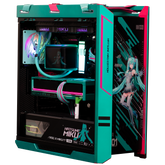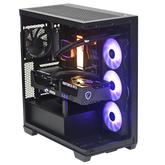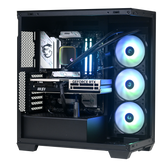Technical Support
No display/blank screen
Make sure the monitor is plugged in and powered on.
Check that the input source is set to the correct connection (HDMI, DVI-D, or Displayport).
Confirm the display cable is plugged into the DVI-D, HDMI or Displayport ports on the horizontal graphics card and not the vertical HDMI port. The onboard ports on the motherboard (top left silver bracket) will only work with a CPU with integrated graphics chip.
Confirm that the monitor cable is plugged into the monitor output port, not the input port if any.
Reseat the graphics processing unit (GPU), and RAM modules.
To reseat the GPU, take off the side panel and remove the screw(s) mounting the GPU onto the bracket on the left side with a Phillips-head screwdriver. Press plastic tab on the right side of the motherboard slot that the GPU is inserted to in order to release the card. Slowly rock the GPU back and forth horizontally towards yourself to remove the GPU. Reinsert it, making sure it is firmly secured and reinsert the screws.
Reseat the RAM module in a different slot than originally installed, making sure that the center notches align correctly and that the locking tabs on the top and bottom (if available) snap into place.
You will hear 1 click for each side that is correctly inserted, 2 clicks total. If you have more than one RAM module, check each one at a time in order to isolate the defective component.
Ensure that the CPU power cable (black or black/yellow) on the top left of the motherboard is inserted securely by removing it and plugging it back in.
Take the CMOS battery (silver coin) out, wait a minute for it to drain and then reinsert it into the motherboard.
If your monitor uses a port that is not on the graphics card such as VGA or DVI-D, you may need to use an adapter. For VGA specifically, you will need an ACTIVE adapter to convert the digital HDMI, Display Port, or DVI-D signal to an analog VGA signal.
No power
Check to see the power cable is securely plugged into the power supply unit (PSU) in the back of the computer and into a powered outlet or surge protector. Check another outlet or surge protector if possible.
Make sure the rocker switch on the PSU is set to the ‘1’ or line side, not the ‘0’ or circle side.
Reseat the 24-pin motherboard power cable (next to RAM) and the 4/8 pin CPU cables (top left corner).
Locate the PW SW/RES SW headers on the motherboard and reseat them. Short the PW SW pins with a metal screwdriver by touching the two pins in order to attempt to turn the PC on without the power button.
Perform a power cycle by unplugging the power cable, turning the switch to the ‘0’ side and taking out the CMOS battery from the motherboard. After a minute has passed, press the power button repeatedly in order to drain the capacitors. Plug the power cable in, turn the switch to the ‘1’ side, reinstall the CMOS battery and press the power button again to see if it turns on.
Perform the paperclip test on the 24-pin motherboard power cable to test the PSU.
Check the motherboard and GPU and see if there are any burnt or bulging capacitors or signs/smells of burning/smoke.
Power is turning off and on
Reseat the 24-pin motherboard power cable (next to RAM) and the 4/8 pin CPU cables (top left corner).
Reseat the RAM module, making sure that the center notches align correctly and that the locking tabs on the top and bottom (if available) snap into place. You will hear 1 click for each side that is correctly inserted, 2 clicks total
Power cable does not fit power supply
Double check the fit using another monitor or computer power cable if necessary.
Front 3.0 USB ports not working
Open up the case and check that the USB 3.0 cable is plugged into the appropriate header on the motherboard.
If possible, try a different USB 3.0 header in order to check if it is the port that is defective.
No USB ports are working
Perform a power cycle by unplugging the power cable, turning the switch to the ‘0’ side, replug any USB connections and taking out the CMOS battery from the motherboard.
After a minute has passed, press the power button repeatedly in order to drain the capacitors. Plug the power cable in, turn the switch to the ‘1’ or line side, reinstall the CMOS battery and then turn the PC on.
Select boot device/booting into BIOS/UEFI
Check and ensure that the SATA data and SATA power cables are connected to the hard drive disk (HDD)/ solid state disk (SSD).
Follow the data cable from the HDD/SSD(s) to the motherboard and reseat those connections as well.
Defaultuser0/Locked Administrator account on login
Defaultuser0 is the hidden account from when you first startup the computer and customize your account preferences. If the first startup is interrupted, it may boot up to a login screen with defaultuser0 as the account name. You will not be able to login using this account as it is not set up for regular use. You can bypass it with the following steps:
From the login screen, hold the shift key and click the restart button to restart the computer.
Click on Troubleshoot, Advanced and then Startup Settings.
At the Startup settings, select “Safe Mode with Networking”. It should fail to boot and restart.
If you still get defaultuser0, go back to the Start settings menu and select “Safe Mode with Command Prompt” instead.
Type in the following commands and hit enter after each line.
net user administrator /active:yes
net user defaultuser0 /DELETE
Secondary drive is not showing up
Check and ensure that the SATA data and SATA power cables are connected to the drive. If the drive is connected and visible in BIOS but not reflected in Windows, perform the following steps:
In Windows, right-click the Start menu icon and select ‘Disk Management’.
Right-click the missing disk and click ‘Initialize Disk’. Click OK to accept the default settings.
Right click the unallocated (black) region on the missing disk and select ‘New Simple Volume’.
Click ‘Next’ through each of the options and then click ‘Finish’. The missing drive should then appear.
Headset speakers or headset microphone only work separately
Check to see if your cable terminates into a single male jack.
If so, the male jack will provide both input and output for laptops and consoles. However, you will need a splitter to use it for PC. Make sure the speaker jack goes into the green (headset icon) port while the microphone jack goes into the pink (microphone icon) port.
In Windows, right click the sound icon, open sound settings and ensure the input (microphone) and output (speaker) devices are set to the correct devices.
Freezing during gameplay
Make sure you have the latest drivers for your graphics processing unit (GPU), as they may contain fixes concerning any game-related issues you are experiencing.
Uninstall and perform a clean install of the drivers.
Using a program called ‘HWMonitor’, check the temperatures of your CPU and GPU and make sure they are not above their maximum threshold. Temperatures at or above 90°C (194°F) can cause damage to your components and crash your software.
Low FPS during gameplay
Check the GPU in order to see that it is connected properly. If the GPU cannot be detected, the computer may use the integrated graphics in order to output a display.
Check to see if processes such as Windows Update, Steam, Epic Games Store, etc. are running in the background.
Run an anti-virus and anti-malware scan to see if malicious processes are running in the background.
While in use, the display goes blank
Try turning off hybrid sleep. To do this, perform the following:
In Windows, go to ‘Power Options’ -> ‘Additional power settings’ -> ‘ Change plan settings -> ‘Change advanced power settings’ -> ‘Sleep’ -> ‘Allow hybrid sleep’ -> Setting: Off
No audio
Make sure the speakers are receiving power and are plugged into either the green or blue colored port on the motherboard.
Check the volume control by clicking the speaker icon on the bottom right and selecting ‘Volume Mixer’. Confirm that the devices and applications are not muted.
Check the default audio devices by selecting ‘Sounds’ from the menu before and make sure that the correct audio devices are set.
CPU Fan error on boot-up
Check to see the CPU fan/All-In-One CPU water cooler 4-pin power cable is plugged in correctly to the motherboard and reseat it.
Windows is un-activated
A Windows 10 digital license is associated with your PC hardware. In order to reactivate Windows 10 after reinstalling the operating system, go to Windows Settings -> Update & Security -> Activation -> Troubleshoot. If the key does not reactivate from the troubleshooter, please email us at support@stoneforged.tech
Why are my GPU fans not spinning?
Many of the graphic cards that are installed into our PCs have fans that do not spin when the card is idling. The fans will spin while playing a game that pushes the card enough to reach a certain temperature threshold.
My case fans are not lighting up
On some of our models, there is a fan and RGB controller board that often gets shaken up during shipping. If you remove the right side panel, you should see it against the backplate. Please make sure all the cables are firmly connected to the board. There should be one cable on the bottom edge, two on the top, and the fans and RGB headers plug into the sides.
If there is a molex connection, check to see if the 2-pin molex cables are plugged into the 4-pin molex cables. If not, the fans will spin but the lights will be off.
I can’t connect to my wi-fi/connection is poor
If you are experiencing no/poor wi-fi connection, please ensure that the included antennas are screwed on to the golden connectors on the back of your PC.
Check to see that other devices are receiving internet. Try rebooting the router. If possible, try a different wi-fi adapter or ethernet cable. Try reinstalling drivers via this link.
Lastly, you can try the following steps:
- Hold the Windows Key and press X.
- Select Windows Powershell (Admin).
- Input the following commands and hit enter: ipconfig /registerdns ipconfig /release ipconfig /renew netsh winsock reset netsh int reset
- Reset your PC.
- Choosing a selection results in a full page refresh.







